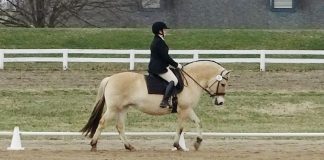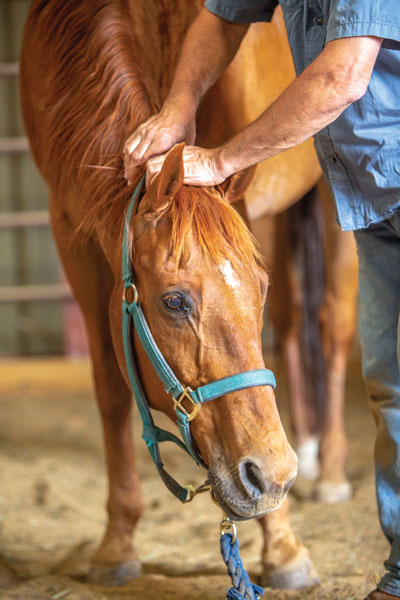
As a horse owner, you rely on your partnership with your veterinar- ian to keep your horse healthy and moving well. But what can you do to keep your horse feeling good in-between veterinary or equine chiropractic visits? And what can you do to help your horse remain calm in an emergency—before trained help arrives? Massaging and stretching your horse can help you build a trusting bond. Plus, you can learn techniques that will keep your horse out of shock if there is an emergency. Here, we’ve highlighted three bodywork techniques that you can learn to do with your horse—the Masterson Method, TTouch, and stretching.
“You build a better relationship with your horse when you are interacting daily,” says Schlutz. “It helps your horse relax and helps you bond. If you learn to do some bodywork, you can see what’s changing with your horse. You’ll know how your horse usually moves and if there’s a change that may require a visit.”
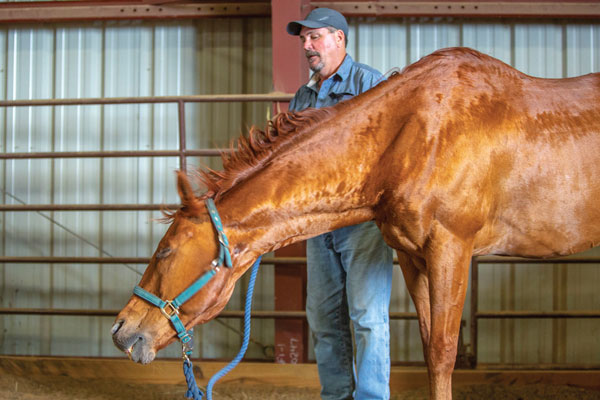
Masterson Method
WHAT IT IS: Masterson Method bodywork relies on the horse’s response to your touch to find and release tension. After working as a massage therapist for performance horses, founder Jim Masterson found that using light touch often resulted in big responses. He developed his own techniques, which teach you to watch for your horse’s reactions and continue light massage based on how your horse responds.
“It is something you do with the horse rather than to the horse,” he says.
Interacting with your horse helps you see the subtle signs of body pain before there’s a big issue. If you notice where your horse is holding tension, you can work with your horse to release it.

TECHNIQUE TO TRY: Trace your horse’s bladder meridian (which runs through a horse’s poll, shoulders, withers and hind end) with your hand to help him release tension. A meridian is a pathway in the body where energy flows from organ to organ. Masterson says that by tracing meridians with soft touch, you can help your horse release tension. Watch a video clip online at www.bit.ly/mastersonbladder from “Mas- terson’s Light to the Core” video to see how to work on this meridian.
“It’s a chance to put together a picture of what’s going on [and] where in the horse’s body,” says Masterson.
With your horse haltered, use your hands to softly trace along the meridian line. It starts over the horse’s eye, goes between the ears to the poll, follows along the mane, along the side of the spine and moves to the hamstring muscles. It continues to the hock, down the leg and to the outside of the coronary band.
As you work, notice if your horse blinks, yawns, licks or chews. Don’t push or rub but maintain a light touch. If your horse responds, you can stay and hold light pressure.
“You’re looking for a change in behavior that correlates with what you’re doing with your hand,” says Masterson.
TTouch
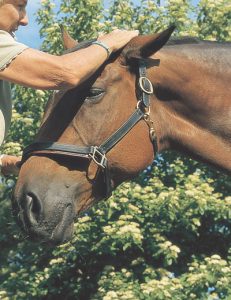
WHAT IT IS: Tellington TTouch includes light, circular and sliding touches to bring your horse into a state of rest and recovery while you wait for the veterinarian to arrive or after any treatment. The touches also help calm sore muscles and relax nervous horses. The work activates your horse’s parasympathetic nervous system—part of the autonomic nervous system that relaxes the body and slows high-energy functions, such as the heart rate.
TTouch can speed healing and recovery from injury and illness in horses and in all animals, including humans, says founder Linda Tellington-Jones, PhD.
“You can make a difference in your horse’s health and well-being and develop a stronger trust,” says Tellington-Jones.
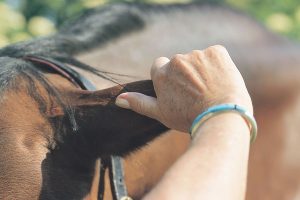
TECHNIQUE TO TRY: Tellington-Jones recommends that all horse owners learn the Ear TTouch. You’ll slide your fingers over your horse’s ear from the base to the tip.
“With the ear slides, you can bring a horse out of shock or keep him out of shock until your veterinarian can get there,” she says. “And even after the vet is there, the slide from the base of the ear out to the tips puts the entire system—and brings the horse—into a state of rest and recovery. You can save the life of your horse with this.”
The full process is outlined in The Ultimate Horse Behavior and Training Book. To start, lower your horse’s head, then smoothly stroke from the middle of his poll, over the base of his ear and slide out to the tip. Finish with a little twist between your fingers and thumb as you glide off the tip of the ear. Once your horse feels comfortable, repeat while sliding your thumb along the inside of his ear as you also stroke the outside. Next, bring your horse’s ear out to the side and slide your hand from base to tip.
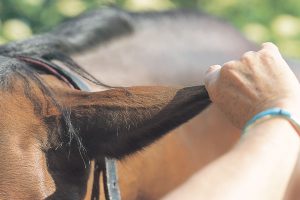
“Remember to hold the halter’s noseband on the opposite side from the ear so you can balance the slight pull with a little resistance, as well as keep the horse’s head straight,” says Tellington-Jones. “Some horses enjoy or tolerate only light, slow strokes unless they are in pain or shock. In this event, you should stroke fast and firmly, and keep it up until the horse is comfortable and his pulse and respiration return to normal ranges, or until your vet arrives.” To finish, hold the front of the noseband to lower the head and stroke the ear with the back of the hand from forehead to neck.
Stretch Your Horse
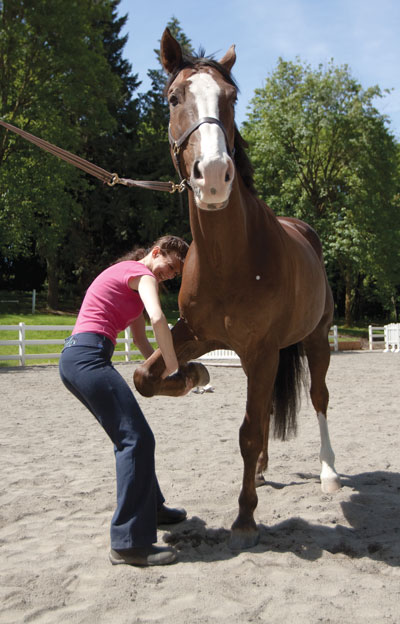
WHAT IT IS: Horses in all disciplines can benefit from stretching to keep them in top shape and prevent injuries and lameness. By learning to effectively stretch your horse’s muscles, you can improve comfort and performance and also help prevent injury and down time. Plus, you’ll boost your bonding time and know how your horse is moving each day.
An app called Stretch Your Horse contains 25 video tutorials so you can learn to safely stretch the horse’s major muscle groups. Ilene Nessenson, a certified equine bodyworker who studied equine exercise physiology, created the video-based app.
HOW IT HELPS: Stretching your horse can help improve flexibility and range of motion. Stretching also helps prevent injuries and lameness by strengthening supportive tissues while guarding against muscle tightness.
“Studies also show stretching guards against tendon shortening, which can lead to premature musculoskeletal aging,” says Nessenson. “Plus, it can help reduce post-exercise soreness and can aid in injury rehabilitation.”
TECHNIQUE TO TRY: “One very important stretch every horse needs is the Front Leg and Pectoral (‘armpit’) Muscles Stretch,” she says.
This stretch targets the horse’s pectoral muscles (running down the horse’s chest and into the armpit area). It also stretches the extensor muscles on the front and inside of the front legs. Watch the free how-to video at www.bit.ly/horsestretch.
Resources◆ Jim Masterson offers in-person training workshops and certifies practitioners. check out his DVD series and books on the Masterson Method and more at www.mastersonmethod.com. |
This article on three ways to stretch a horse (the Masterson Method, TTouch, and stretching) appeared in the February 2020 issue of Horse Illustrated magazine. Click here to subscribe!




